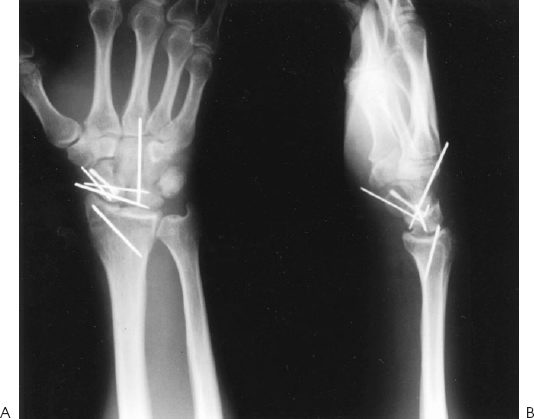59
Radial Styloid Fractures
James H. Calandruccio
History and Clinical Presentation
A 40-year-old man lost control of his four-wheeler and landed on his dominant wrist. He was initially examined at a local emergency room where a closed deformity about the wrist level was observed. A thumb-spica splint was applied, and he was referred to an orthopedic surgeon whom, he saw 5 days after his original injury.
Physical Examination
There is moderate swelling of the hand to the metacarpophalangeal joint level, with sensation diffusely diminished in the hand, most predominantly in the median nerve distribution.
Diagnostic Studies
Posteroanterior and lateral radiographs revealed a radial styloid fracture associated with a displaced fracture of the waist of the scaphoid (Fig. 59–1). No other abnormalities were noted on films of the hand, forearm, or elbow.
PEARLS
- Radial styloid fractures can be accompanied by disruption of the scapholunate ligament in addition to other carpal fractures besides the scaphoid.
- Rigid carpal fracture fixation and anatomic restoration of the distal radial articular surface and intercarpal relationships are prerequisites for satisfactory wrist function.
PITFALLS
- Biplanar roentgenograms of radial styloid fractures may not represent concomitant intercarpal ligamentous injury.

Figure 59–1. Posteroanterior (A), oblique (B), and lateral (C) roentgenograms of wrist with radial styloid and scaphoid fractures with concomitant scapholunate dissociation.
Differential Diagnosis
Radial styloid fracture
Radial styloid fracture with scaphoid fracture
Radial styloid fracture with scaphoid fracture and scapholunate dissociation or other perilunar injury
Diagnosis
Displaced Radial Styloid Fracture with a Displaced Scaphoid Waist Fracture and Acute Carpal Tunnel Syndrome
Fractures of the radial styloid may be the direct result of shearing forces or from avulsion forces through the strong extrinsic radiocarpal ligaments. Simple partial intraarticular fractures of the distal radial lateral surface without comminution (AO classification B 1.1) may occur in isolation or represent the radial initiation of a more complex dissipation of energy. Experimental loading of 32 cadaver wrists with wrist extension, ulnar deviation, and intercarpal supination produced seven radial styloid fracture patterns. Most of these were styloid body fractures from radiocapitate ligament avulsions rather than styloid tip fractures from radial collateral ligament avulsions. Nondisplaced radial styloid body fractures are commonly associated with injuries to the scapholunate ligament complex. The association of intercarpal injuries has been elucidated through an arthroscopic evaluation of intraarticular distal radial fractures. Over 20% of intraarticular distal radial fractures were found to have concomitant scapholunate disruptions. Although, the combination of scaphoid fracture with scapholunate diastasis is rare, it can occur in combination with a radial styloid fracture. Transcapitate or transtriquetral injuries also have been seen with styloid body fractures, in addition to dynamic or static scapholunate instability.
Radial styloid fractures without obvious intercarpal malalignment in patients who have suspected intercarpal ligament injuries may benefit from adjunctive wrist arthroscopic management, but it is the author’s opinion that surgical management of acute partial scapholunate ligament tears associated with distal radial fractures is probably rarely warranted.
Surgical Management
During the 7 days before surgery, a splint was applied and the upper extremity maximally elevated to reduce swelling. Operative procedures included open reduction and internal fixation of the scaphoid with an antegrade screw and 0.054-inch Kirschner wire, closed reduction and pinning of the distal radial fracture with Kirschner wires, repair of the scapholunate interosseous ligament, intercarpal pin stabilization, and open carpal tunnel release (Fig. 59–2).
The scaphoid was exposed through a longitudinal dorsal incision. The proximal pole of the scaphoid was found to be completely detached from the scapholunate interosseous ligament. Secure fixation of the scaphoid fracture was accomplished with an antegrade Herbert screw. Direct visualization of the intraarticular radial styloid fracture assisted reduction before percutaneous Kirschner pin fixation. Maintenance of the proper capitolunate orientation was achieved with a retrograde Kirschner wire from the capitate to the lunate (Fig. 59–3). The scapholunate joint was then reduced and two 0.054-inch Kirschner wires were used to maintain the normal scapholunate relationship.










